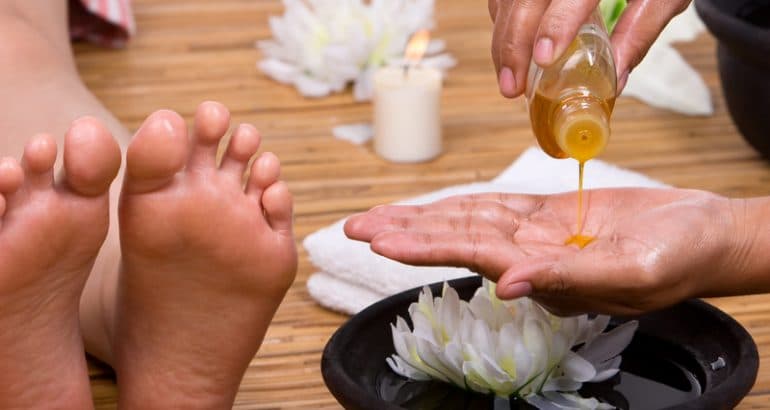1. Lavender
Lavender is my very first recommendation for pain and inflammation. As I have mentioned in previous articles, Lavender is considered the ‘Swiss Army Knife' of essential oils. Every household should have this powerful essential oil.
There have been countless research studies conducted on the effects of Lavender.One study in 2012 showed a significant pain reduction for migraine sufferers. The severity of their migraines was reduced after simply inhaling Lavender.
Another study, conducted in 2013, treated children who had just undergone a tonsillectomy. The test subjects inhaled Lavender as part of their healing process, and subsequently, their necessity for acetaminophen post-surgery was reduced.
A study in 2015 showed that the anti-inflammatory analgesic pain relief properties of Lavender can be comparable to some prescription pain relievers.
3 Different Ways To Use Essential Oils:
- Inhalation
Your olfactory system is one of the most powerful senses that you have. As mentioned in a previous article, when you inhale an essential oil, it actually goes into the limbic system of your brain and can affect your emotions and your mood.
Just add one or two drops to your palm, then rub your hands together and inhale deeply from your nose. This is the easiest way to and benefit quickly.
- Diffuser
Add 3 to 15 drops of the oil, depending on your specific diffuser. You can diffuse it in your house to reap the rewards of Lavender essential oils as a pain reliever and inflammation reducer through your olfactory system.
There is a whole modality of healing, called aromatherapy, that has used essential oils as healing modalities for years.
- Carrier oil
A carrier oil is a regular oil, like coconut oil, avocado, or sweet almond oil. You can add drops of Lavender to a carrier oil apply it to your body.
So, to make maximum use of Lavender as an essential oil for pain and inflammation, inhale it in the palms of your hands, use a diffuser, or apply it directly to the location of your pain.
One of the most recommended places to apply essential oils is at the base of your skull, where your skull meets your neck. Essential oil molecules are so minute that they penetrate the epidermis very quickly and enter into the bloodstream.
This can actually impact your brainstem and reduce the body's drive to push out some of those chemicals (noradrenaline and cortisol) in the body that are associate with stress.
2. Wintergreen
Wintergreen oil contains methyl salicylate, which is basically nature's aspirin. It is a phenomenal anti-inflammatory and analgesic, so it acts well as a painkiller. Wintergreen is very concentrate, so it can be toxic if ingested in large quantities.
Similar to Stinging Nettles, Wintergreen is safe to take internally in a tea, but if you rub it on your body, you can get a rash. I suggest mixing Wintergreen with a carrier oil and applying it topically to the affected area of your body.
Wintergreen is also believe to be one of the best inflammation-fighting compounds in the world. It has a slight numbing effect and it also contains antioxidants that are really good for pain management.
Wintergreen is one of the only plants that have enough concentrated methyl salicylate that can be extracte and use as a supplemental product.
A combination of wintergreen and peppermint is also highly recommend. I recommend combining 10 drops of wintergreen and 10 drops of peppermint in a carrier oil, then using it as a massage rub on your body.
If you get a burning sensation from applying a non-diluted essential oil directly to your skin, I recommend rubbing a pure oil, like olive oil, into that painful spot. This action should remove the pain brought on by the essential oils for pain and inflammation.
In 2004, 14 studies published in the Journal of Complementary and alternative medicine, concluded that the combination of peppermint and Wintergreen was particularly effective in reducing inflammation.
3. Frankincense
I love frankincense! Frankincense is an excellent general pain reliever and it has excellent anti-inflammatory properties. Frankincense comes from the Boswellia tree.
One experiment centered around aromatherapy hand massages with frankincense given to people with cancer. Surprisingly their pain was significantly reduce. This oil is also good for people with arthritis.
If you have questions about essential oils, you can reach Shyloe Fayad on Facebook, or email her at [email protected].
Shyloe Fayad is Okanagan-based and the CEO & Primary Wonderer at Radical Wondering Collective. She is also the founder of “Happiness Habits by Shyloe”, which is a unique and actionable system that helps you reduce stress, depression, and anxiety, so you can live your best life. She has been an essential oil user since the late ’90s and is now an educator. In this article, she discusses 3 powerful essential oils for pain and inflammation.
This article will benefit anyone suffering from acute or chronic pain, arthritis, or inflammation.
Discover the power of healing through food with our Anti-Inflammatory Cookbooks Bundle! Say goodbye to discomfort and hello to vitality with delicious recipes designed to reduce inflammation and promote wellness. Take charge of your health today and embark on a journey to a happier, healthier you. Grab your bundle now and start cooking your way to a vibrant life!





